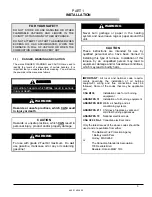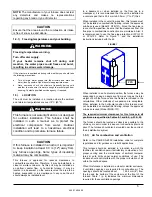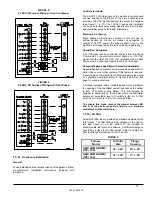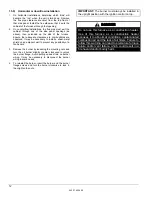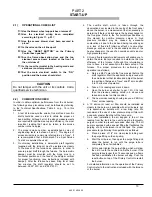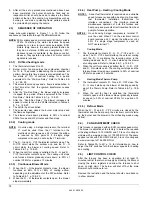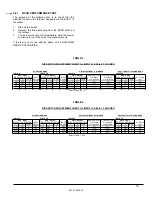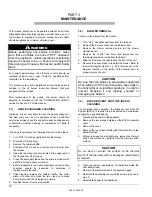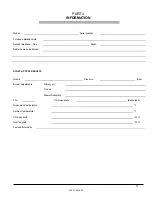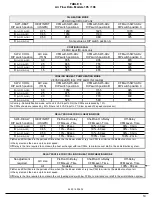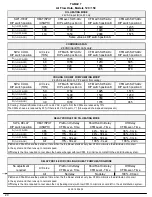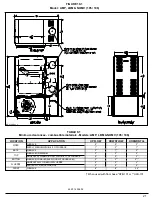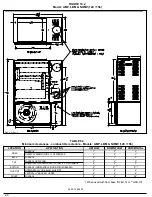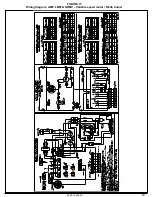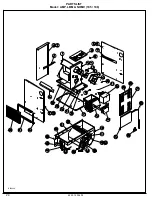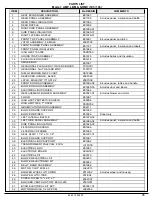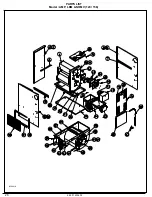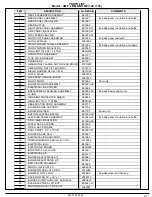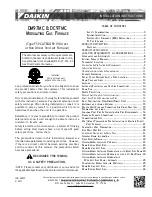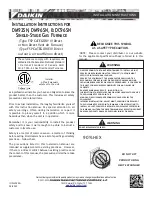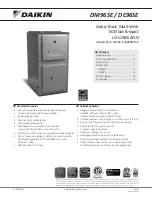
PART 2
START-UP
13
2.1) OPERATIONAL
CHECKLIST
1=>
Has the blower wheel support been removed?
2=>
Has the electrical wiring been completed
according to Figure 11, p. 23?
3=>
Has the access blower door been secured in
place?
4=>
Is the valve on the oil line open?
5=>
Has the ‘’RESET BUTTON’’ on the Primary
Control been pushed?
6=>
Are the flame observation door and the two
cleanout access doors located at the front of
the unit closed?
7=>
Is the room thermostat in the heating mode and
set above room temperature?
8=>
Set the main electrical switch to the ‘’ON’’
position and the burner should start
.
CAUTION
Do not tamper with the unit or its controls. Call a
qualified service technician.
2.2) COMBUSTION
CHECK
In order to obtain optimum performance from the oil burner,
the following set-up procedures must be followed by referring
to the Technical Specifications, Table 5 on p. 19 in this
manual:
1. A test kit to measure the smoke, flue draft and over-fire
draft should be used in order to obtain the proper air
band setting. Although all of the above measurements
are required for optimum set-up and efficiency, the most
important reading that must be taken is the smoke
number in the flue pipe.
2. The proper smoke number, as established by way of
engineering tests, is between 0 and 1. This degree of
smoke emission is commonly referred to as a “trace”. It
is recommended that a Bacharach True Spot Smoke
Test kit or equivalent be used;
3. On chimney installations, a barometric draft regulator
(supplied with the furnace) must be installed as closely
to the breech of the furnace as possible, in order to
ensure proper draft through the furnace. The barometric
damper must be mounted with the hinge pins in a
horizontal position and the face of the damper vertical
for proper functioning, (see instructions included with
damper). After the furnace has been firing for at least
five minutes, the draft regulator should be set to
between -0.025" W.C. and -0.035" W.C.;
4.
4. The overfire draft, which is taken through the
observation door located in the centre of the front panel
above the burner, is a measurement that is necessary to
determine if there is a blockage in the heat exchanger or
the flue pipe. Refer to the Technical Specifications in
this manual for overfire pressure values. A high
pressure condition may be caused by excessive
combustion air due to the air band being too wide open
or a lack of flue draft (chimney effect) or some other
blockage, such as soot in the secondary section of the
heat exchanger or the use of an oversize nozzle input or
high pressure pump;
5. CO
2
and flue temperature instruments will enable you to
obtain the data that are required to determine the true
efficiency of the furnace. Although this information is
nice to have, it is not essential in the basic set up of the
furnace. The proper procedure for performing this
operation is as follows:
a. Pierce a 9/32" hole into the flue pipe just before the
draft regulator. Start the appliance and proceed with
the smoke test at that location and adjust the burner
to a setting of between a “trace” and #1 smoke after
5 to 10 minutes of operation;
b. Take a CO
2
reading and mark it down;
c. Open the burner air shutter to get 1.5% CO
2
less
than the previous reading noted in b. above and
take a smoke test on this condition;
d. The new smoke reading should give you a ZERO or
“trace” smoke reading.
6. A 10 micron (or less) oil filter should be installed as
closely to the burner as possible with all oil burners, but
it is essential for burners with a low firing rate. We
recommend the use of a low pressure drop oil filter with
a capacity greater than that of the fuel pump;
7. On a new installation, the air trapped in the oil line
leading from the tank to the nozzle must be thoroughly
purged in order to prevent excessive after drip. The oil
pump is equipped with a special fitting that facilitates the
purging of any air between it and the tank. The proper
procedure for performing this operation is as follows:
a. Place a piece of 1/4" dia. clear plastic tubing over
the purge fitting on the oil pump;
b. Start the oil burner, then open the purge fitting and
allow the burner to run until the purge tube is
completely free of air bubbles;
c.
At this point tighten the purge fitting, which will allow
the oil to run to the nozzle and fire the burner. If the
purging takes longer than 15 seconds and no flame
has been established the burner will stop. Push the
reset button on top of the Primary Control to restart
the burner.
For detailed information on the operation of the Primary
Control refer to the instructions included with the furnace
or the burner.
445 01 4036 02


